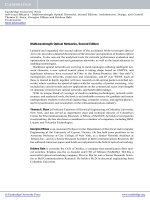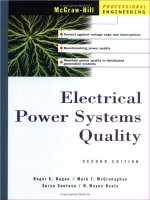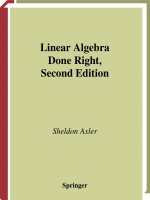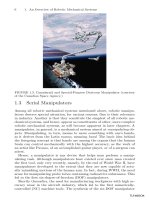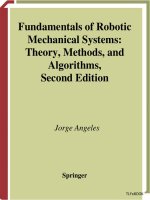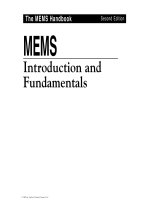liquid filtration, second edition
Bạn đang xem bản rút gọn của tài liệu. Xem và tải ngay bản đầy đủ của tài liệu tại đây (27.94 MB, 334 trang )
FILTRATION
by
Nicholas
P.
Cheremisinoff, Ph.D.
Environmental Policy and Technology Project
United States Agency
for
International Development
Boston
Oxford
Johannesburg Melbourne New Delhi Singapore
LIQUID
Copyright
©
1998
by
Butterworth-Heinemann
A
member
of the
Reed Elsevier group
All
rights reserved.
No
part
of
this publication
may be
reproduced, stored
in a
retrieval system,
or
transmitted
in
any
form
or by any
means, electronic, mechanical, photocopying, recording,
or
otherwise,
without
the
prior written permission
of the
publisher.
Recognizing
the
importance
of
preserving what
has
been written, Butterworth-Heinemann
prints
its
books
on
acid-free paper whenever possible.
Butterworth-Heinemann supports
the
efforts
of
American
Forests
and the
Global ReLeaf program
in its
campaign
for the
betterment
of
trees, forests,
and
our
environment.
ISBN:
0-7506-7047-9
The
publisher
offers
special discounts
on
bulk
orders
of
this book.
For
information,
please
contact:
Manager
of
Special Sales
Butterworth-Heinemann
225
Wildwood Avenue
Woburn,MA01801-2041
Tel:
781-904-2500
Fax: 781-904-2620
For
information
on all
Butterworth-Heinemann publications available, contact
our
World
Wide
Web
home page
at:
10
987654321
Printed
in the
United
States
of
America
DEDICATION
This volume
is
dedicated
to the
memory
of
Paul
N.
Cheremisinoff, M.S., P.E.,
who
authored more than
300
technical books over
his
career
as a
chemical engineer
and
was
among
the
pioneers
of
pollution control
and
prevention.
This page intentionally left blank
CONTENTS
Preface
ix
About
the
Author
xi
Chapter
1 An
Introduction
to
Liquid Filtration
1
Introduction
1
The
Porous Media
2
The
Filter
Media
9
Liquid Filtration Classification
10
The
Formation
of
Filter
Cake
11
Typical Industrial Filtration Conditions
12
Washing
and
Dewatering Operations
12
General Considerations
for
Process Engineers
13
The
Objectives
of
Filtration
14
Preparation Stages
for
Filtration
15
Equipment Selection Methodology
16
Nomenclature
18
Chapter
2
Filter Media
and Use of
Filter Aids
19
Introduction
19
Flexible
Filter
Media
20
Rigid Filter Media
34
Filter Media Selection Criteria
43
Introduction
to the Use of
Filter Aids
47
Examples
of
Filter Aids
50
Filter
Aid
Selection
51
Suggested Readings
57
Nomenclature
58
Chapter
3
Cake Filtration
and
Filter Media Filtration
59
Introduction
59
Dynamics
of
Cake
Filtration
60
Constant-Rate
Filtration
70
Contents
Variable-Rate
and
-Pressure Filtration
72
Constant-Pressure
and
-Rate Filtration
75
Filter-Medium
Filtration
Formulas
75
Constant-Pressure-Drop Filtration
75
Filtration
Mechanisms
81
Constant
Rate Filtration
83
Suggested
Readings
86
Nomenclature
87
Chapter
4
Industrial Filtration Equipment
88
Introduction
88
Rotary
Drum
Filters
89
Cocurrent
Filters
91
Cross
Mode
Filters
98
Cartridge
Filters
103
Diaphragm
Filters
110
High
Pressure, Thin Cake Filters
115
Thickeners
117
Solids Washing
120
Centrifugal
Filtration
120
Screw
Presses
123
Ultrafiltration
124
Reverse
Osmosis
134
Closure
141
Chapter
5
Application
of
Filtration
to
Wastewater Treatment
142
Introduction
142
Granular
Media Filtration
142
Bed
Regeneration
148
Flocculation
Filtration
149
Slow
Sand Filtration
151
Rapid
Sand Filtration
153
Chemical Mixing, Flocculation,
and
Solids Contact
Processes
155
Suggested
Readings
162
Chapter
6
Advanced Membrane Technology
for
Wastewater Treatment
163
Introduction
Overview
of
Technology Case
Study
Case
Study
Specifics
Technology Application
Mechanisms
of
Membrane Separations
Treatment
of
Hazardous Wastes
Contents
vii
Features
of the
Hyperfiltration System
173
Process Economics
184
Detailed Process
and
Technology Description
193
Summary
of
Case Study Analytical Results
202
Closure
210
Chapter
7
Sludge
Dewatering
Operations
211
Introduction
211
Overview
of
Dewatering Technologies
212
Use
of
Drying Beds
217
Use
of
Vacuum Filtration
219
Use
of
Pressure Filtration
222
Use
of
Centrifugation
223
Alternative Mechanical Dewatering Techniques
226
Suggested Readings
227
Chapter
8
Industrial Wastewater
Sources
229
Introduction
229
Paper
and
Allied Products Industry Wastes
230
Dairy
Products Industry Wastes
232
Textile Industry Wastes
237
Pharmaceutical Industry Wastes
240
Leather Tanning
and
Finishing Industry Wastes
243
Petroleum Refining Industry Wastes
246
Food
and
Meat Packing Industry Wastes
251
Beverages
Industry Wastes
254
Plastics
and
Synthetic Materials Industry Wastes
258
Blast
Furnaces, Steel Works,
and
Rolling
and
Finishing Wastes
261
Organic
Chemicals Industry Wastes
265
Metal
Finishing Industry Wastes
268
Closure
271
Suggested Readings
271
Chapter
9
Filtration
Equipment
and
Process
Flow
Sheets
272
Introduction
272
Index
to
Equipment
and
Flow Sheet Diagrams
272
Index
316
This page intentionally left blank
PREFACE
This
volume
has
been
written
as an
introductory reference
and
working guide
to the
subject
of
liquid filtration engineering.
The
book
is
designed
to
acquaint
the
newcomer
to
industry
practices,
and
general
design
and
operating methodology
for
filtration
processes. Emphasis
is
given
to
pollution
control applications, however
the
technologies
and
equipment
described
herein
are
equally
applicable
to
product
recovery
and
product purification applications.
The
information presented
in
this volume
is
based largely
on the
author's collected
notes
and
lectures over
the
past
15
years.
The
volume
is not
intended
for
researches
or
equipment developers,
but
rather
for
process engineers, plant engineers,
and
technicians
who
require
basic
knowledge
of
this important unit operation. Much
of the
design
methodology
and
working equations presented have been tested
on
pilot plant
studies
and
applied
to
commercial
and
semi-commercial operations with success,
however,
neither
the
author
nor
publisher provide written
or
implied endorsements
that
these procedures will work
in any or all
cases.
As
with
any
piece
of
equipment
or
process,
the
designer must consult with specific vendors, suppliers
and
manufacturers,
and
further, should field test
or at a
minimum, conduct pilot tests
to
ensure
performance
in the
intended application. Filtration equipment, operation
conditions,
and the use of
filtration aids
are
highly dependent upon
the
properties
of
the
suspension being filtered. Furthermore, overall process constraints
and
economics
can
have
major
impacts
on the
selection
of
equipment, their operating modes
and
characteristics,
and
efficiency.
The
author wishes
to
extend
a
heartfelt gratitude
to
Butterworth
—
Heineinann
for
their
fine
production
of
this volume,
and to
members
of the
United States
Environmental
Protection Agency
for
their advise
and
consultation
on
some
of the
materials
presented herein.
Nicholas
P.
Cheremisinoff,
Ph.D.
This page intentionally left blank
ABOUT
THE
AUTHOR
Nicholas
P.
Cheremisinoff
is
Director
of the
Industrial Waste Management Program
in
Ukraine, which
is
supported
by the
United States Agency
for
International
Development, Washington D.C.
He has
nearly
twenty
years
of
applied research
and
industry
experience
in the
petrochemicals,
oil and
gas, rubber,
and
steel
industries,
and is
considered
a
leading authority
on
waste management
and
process design.
Dr.
Cheremisinoff
provides technical consulting services
to
both private industry
and
government
agencies
and has
worked extensively
in
Republics
of the
former
Soviet
Union,
South America, Korea,
the
United States,
and
Western Europe,
He is the
author, co-author,
or
editor
of
over
100
engineering reference books dealing with
waste
technologies
and
process designs, including
the
multivolume Encyclopedia
of
Fluid
Mechanics
by
Gulf Publishing Company.
Dr.
Cheremisinoff
received
his
B.S.,
M.S.
and
Ph.D. degrees
in
chemical engineering
from
Clarkson College
of
Technology.
This page intentionally left blank
AN
INTRODUCTION
TO
LIQUID
FILTRATION
introduction
In
the
simplest
of
terms, filtration
is a
unit operation that
is
designed
to
separate
suspended particles
from
a
fluid
media
by
passing
the
solution through
a
porous
membrane
or
medium.
As the fluid or
suspension
is
forced through
the
voids
or
pores
of
the
filter
medium,
the
solid particles
are
retained
on the
medium's surface
or,
in
some
cases,
on the
walls
of the
pores,
while
the fluid,
which
is
referred
to as the
filtrate ,
passes through.
The flow of fluids
through
a
porous medium
is of
interest
not
only
to the
unit
operation
of
filtration,
but to
other processes, such
as
adsorption,
chromatography,
operations involving
the flow of
suspensions through packed columns,
ion
exchange,
and
various reactor engineering applications.
In
petroleum engineering
applications,
interest
lies
in the
displacement
of oil
with
gas,
water
and
miscible
solvents (including
solutions
of
surface-active agents),
and in
reservoir
flow
problems.
In
hydrology,
interest
is in the
movement
of
trace pollutants
in
water systems,
the
recovery
of
water
for
drinking
and
irrigation,
and
saltwater encroachment into freshwater reservoirs.
In
soil
physics,
interest
lies
in the
movement
of
water, nutrients
and
pollutants into
plants.
In
biophysics,
the
subject
of flow
through porous media touches upon
lif e
processes
such
as the flow of
fluid s
in the
lungs
and the
kidney.
The
physical parameters that relate
the
porous material
to the
hydrodynamics
of flow
are
porosity,
permeability,
tortuosity
and
connectivity. This chapter discusses
the
fundamentals
of flow
through porous media
and
relates these principles
to the
industrial
operations
of filtration. As
indicated
in the
preface
of
this volume,
the
subject
of
filtration
is
discussed
from
a
process
engineering viewpoint,
and in
particular
from
that
of the
chemical engineer. Filtration
has a
long history
in the
chemical engineering
field
both
from
the
standpoint
of the
production
of
high purity
products,
as
well
as a
technology extensively used
in
pollution control
and
prevention.
1
2
Liquid
Filtration
The
Porous
Media
A
porous medium
may be
described
as a
solid containing many holes
and
tortuous
passages.
The
number
of
holes
or
pores
is
sufficiently
great
that
a
volume average
is
needed
to
estimate pertinent
properties.
Pores that occupy
a
definite fraction
of the
bulk
volume constitute
a
complex network
of
voids.
The
manner
in
which holes
or
pores
are
embedded,
the
extent
of
their
interconnection,
and
their location, size
and
shape
characterize
the
porous medium.
The
term porosity refers
to the
fraction
of the
medium
that contains voids. When
a fluid is
passed over
the
medium,
the
fraction
of
the
medium
(i.e.,
the
pores) that contributes
to the flow is
referred
to as the
effective
porosity.
There
are
many materials that
can be
classified
as
porous media, however,
not all of
them
are of
interest
to the
subject
of
filtration.
In
general, porous media
are
classified
as
either unconsolidated
and
consolidated and/or
as
ordered
and
random. Examples
of
unconsolidated media
are
sand,
glass
beads,
catalyst
pellets,
column
packings,
soil,
gravel
and
packing such
as
charcoal. Examples
of
consolidated media
are
most
of the
naturally
occurring rocks, such
as
sandstones
and
limestones. Materials such
as
concrete, cement, bricks, paper
and
cloth
are
manmade
consolidated media. Ordered
media
are
regular packings
of
various types
of
materials, such
as
spheres, column
packings
and
wood. Random media have
no
particular correlating factor.
Porous media
can be
further
categorized
in
terms
of
geometrical
or
structural
properties
as
they relate
to the
matrix that
affects
flow and in
terms
of the flow
properties
that
describe
the
matrix
from
the
standpoint
of the
contained
fluid.
Geometrical
or
structural properties
are
best represented
by
average
properties,
from
which
these average structural properties
are
related
to flow
properties.
A
microscopic description characterizes
the
structure
of the
pores.
The
objective
of
pore-structure analysis
is to
provide
a
description that relates
to the
macroscopic
or
bulk
flow
properties.
The
major bulk properties that need
to be
correlated
with
pore
description
or
characterization
are
porosity, permeability, tortuosity
and
connectivity.
In
studying
different
samples
of the
same medium,
it
becomes apparent that
the
number
of
pore sizes, shapes, orientations
and
interconnections
are
enormous.
Due
to
this complexity, pore-structure description
is
most often
a
statistical
distribution
of
apparent
pore sizes. This distribution
is
apparent because
to
convert measurements
to
pore
sizes
one
must
resort
to
models that provide average
or
model
pore
sizes.
A
common
approach
to
defining
a
characteristic pore size distribution
is to
model
the
porous medium
as a
bundle
of
straight cylindrical capillaries.
The
diameters
of the
model capillaries
are
defined
on the
basis
of a
convenient distribution
function.
Pore structure
for
unconsolidated media
is
inferred from
a
particle
size
distribution,
the
geometry
of the
particles
and the
packing arrangement
of
particles.
The
theory
of
packing
is
well established
for
symmetrical geometries such
as
spheres.
Information
on
particle size, geometry
and the
theory
of
packing allows relationships between pore
size
distributions
and
particle size distributions
to be
established.
An
Introduction
to
Liquid Filtration
3
A
macroscopic description
is
based
on
average
or
bulk properties
at
sizes much larger
than
a
single pore.
In
characterizing
a
porous medium
macroscopically,
one
must deal
with
the
scale
of
description.
The
scale used depends
on the
manner
and
size
in
which
we
wish
to
model
the
porous medium.
A
simplified,
but
sometimes accurate, approach
is
to
assume
the
medium
to be
ideal; meaning homogeneous,
uniform
and
isotropic.
The
term reservoir
description
is
applied
to
characterizing
a
homogeneous system
as
opposed
to
heterogeneous.
A
reservoir description defines
the
reservoir
at a
level
where
a
property changes
sufficiently
so
that more than
a
single average must
be
used
to
model
the flow. In
this sense,
a
reservoir
composed
of a
section
of
coarse
gravel
and a
section
of
fine
sand, where these
two
materials
are
separated
and
have
significantly
different
permeabilities,
is
heterogeneous
in
nature. Defining dimensions,
locating
areas
and
establishing average properties
of the
gravel
and
sand constitutes
a
reservoir description,
and is a
satisfactory approach
for
reservoir-level
type
problems.
Unfortunately,
to
study
the
mechanisms
of flow, the
effects
of
nonideal
media
require more specific
definitions.
Any
discussion
of flow
through porous media inevitably touches upon
Darcy's
law
which
is a
relationship between
the
volumetric
flowrate
of a fluid flowing
linearly
through
a
porous medium
and the
energy loss
of the fluid in
motion.
Darcy's
law is
expressed
as:
Q
=
(1)
A/z
where
A/z
=
Az
+
——
+
constant
P
The
parameter,
K, is a
proportionality constant that
is
known
as the
hydraulic
conductivity.
The
relation
is
usually considered valid
for
creeping
flow
where
the
Reynolds number,
as
defined
for a
porous medium,
is
less than one.
The
Reynolds number
in
open
conduit
flow is the
ratio
of
inertial
to
viscous forces
and is
defined
in
terms
of a
characteristic
length perpendicular
to
flow
for the
system. Using
four
times
the
hydraulic radius
to
replace
the
length perpendicular
to flow and
correcting
the
velocity
with
porosity yields
a
Reynolds number
in the
form:
D
v
p
Re
=
__JLj£L
(3)
Darcy's
law is
considered
valid
where
Re <
1.
4
Liquid
Filtration
The
hydraulic conductivity
K
depends
on the
properties
of the
fluid
and on
the
pore
structure
of the
medium.
The
hydraulic conductivity
is
temperature-dependent, since
the
properties
of the fluid
(density
and
viscosity)
are
temperature-dependent.
Hydraulic
conductivity
can be
written more specifically
in
terms
of the
intrinsic
permeability
and the
properties
of the fluid.
K
=
(4)
where
k is the
intrinsic permeability
of the
porous medium
and is a
function
only
of
the
pore structure.
The
intrinsic permeability
is not
temperature-dependent.
In
differential
form,
Darcy's equation
is:
Q k dp
J~
=
/7
=
-
f
/C\
A
"
J
P)
A
j.
ax
The
minus sign results
from
the
definition
of Ap,
which
is
equal
to
p
2
-
p
l5
a
negative
quantity.
The
term
q is the
seepage
velocity
and is
equivalent
to the
velocity
of
approach
v
ro
,
which
is
also used
in the
definition
of the
Reynolds number.
Permeability
is
normally determined using linear
flow in the
incompressible
or
compressible form, depending
on
whether
a
liquid
or gas is
used
as the flowing fluid.
The
volumetric
flowrate Q (or
Q
m
)
is
determined
at
several pressure
drops.
Q (or
Q
m
)
is
plotted versus
the
average pressure
p
m
.
The
slope
of
this line will yield
the fluid
conductivity
K or, if the fluid
density
and
viscosity
are
known,
it
provides
the
intrinsic
permeability
k. For
gases,
the fluid
conductivity depends
on
pressure,
so
that
K
=
K\
1+-
where
b
depends
on the fluid and the
porous medium. Under such circumstances
a
straight
line results
(as
with
a
liquid),
but it
does
not
pass through
the
origin; instead
it
has a
slope
of bK and
intercept
K. The
explanation
for
this phenomenon
is
that gases
do
not
always stick
to the
walls
of the
porous
medium.
This slippage shows
up as an
apparent
dependence
of the
permeability
on
pressure.
Heterogeneity, nonuniformity
and
anisotropy must
be
defined
in the
volume-average
sense. These terms
may be
defined
at the
level
of
Darcy's
law in
terms
of
permeability. Permeability
is
more sensitive
to
conductance, mixing
and
capillary
pressure
than
to
porosity.
Heterogeneity, nonuniformity
and
anisotropy
are
defined
as
follows.
On a
macroscopic
basis,
they imply averaging over elemental volumes
of
radius
e
about
a
point
in the
media, where
e is
sufficiently large that Darcy's
law can be
applied
for
appropriate Reynolds
numbers.
In
other words, volumes
are
large relative
to
that
of
An
Introduction
to
Liquid Filtration
5
a
single pore. Further,
e is the
minimum radius
that
satisfies such
a
condition.
If
e
is
too
large, certain
nonidealities
may be
obscured
by
burying
their
effects
far
within
the
elemental
volume.
Heterogeneity, nonuniformity
and
anisotropy
are
based
on the
probability density
distribution
of
permeability
of
random macroscopic elemental volumes selected
from
the
medium, where
the
permeability
is
expressed
by the
one-dimensional
form
of
Darcy's
law.
As
noted
earlier,
the
principal
properties
of
nonideal
porous
media that
establish
the
nature
of the
fluid
flow are
porosity, permeability, tortuosity
and
connectivity.
In a
macroscopic sense, porosity characterizes
the
effective
pore volume
of the
medium.
It is
directly related
to the
size
of the
pores relative
to the
matrix. When porosity
is
substituted,
the
details
of the
structure
are
lost.
Permeability
is the
conductance
of the
medium
and has
direct relevance
to
Darcy's
law.
Permeability
is
related
to the
pore size distribution, since
the
distribution
of the
sizes
of
entrances, exits
and
lengths
of the
pore walls constitutes
the
primary
resistance
to flow.
This parameter reflects
the
conductance
of a
given pore
structure.
Permeability
and
porosity
are
related;
if the
porosity
is
zero
the
permeability
is
zero.
Although
a
correlation between these
two
parameters
may
exist, permeability cannot
be
predicted from porosity alone, since additional parameters that contain more
information
about
the
pore structure
are
needed. These additional parameters
are
tortuosity
and
connectivity. Tortuosity
is
defined
as the
relative average length
of a
flow
path
(i.e.,
the
average length
of the flow
paths
to the
length
of the
medium).
It
is
a
macroscopic measure
of
both
the
sinuosity
of the flow
path
and the
variation
in
pore size along
the flow
path. Both porosity
and
tortuosity correlate with permeability,
but
neither
can be
used alone
to
predict permeability.
Connectivity defines
the
arrangement
and
number
of
pore
connections.
For
monosize
pores, connectivity
is the
average number
of
pores
per
junction.
The
term represents
a
macroscopic measure
of the
number
of
pores
at a
junction. Connectivity correlates
with
permeability,
but
cannot
be
used alone
to
predict permeability except
in
certain
limiting
cases.
Difficulties
in
conceptual simplifications result
from
replacing
the
real porous medium
with
macroscopic parameters that
are
averages
and
that relate
to
some idealized model
of
the
medium.
Tortuosity
and
connectivity
are
different
features
of the
pore structure
and
are
useful
to
interpret macroscopic
flow
properties, such
as
permeability, capillary
pressure
and
dispersion.
Porous media
is
typically characterized
as an
ensemble
of
channels
of
various cross
sections
of the
same
length.
The
Navier-Stokes equations
for all
channels passing
a
cross section normal
to the flow can be
solved
to
give:
6
Liquid
Filtration
Where parameter
c is
known
as the
Kozeny
constant, which
is
essentially
a
shape
factor
that
is
assigned
different
values depending
on the
configuration
of the
capillary
(c
=
0.5
for a
circular
capillary).
S is the
specific surface area
of the
channels.
For
other
than circular capillaries,
a
shape
factor
is
included:
~>
ck
r"
- — (8)
l
'
The
specific surface
for
cylindrical pores
is:
„
_
n2nrL
_ 2
^A
J7
~
-
nnr
L
r
and
^2
2(j)
Wk
(10)
s
2
-
>->
A
~
Replacing
2/8
1/4
with shape parameter
c and
S
A
with
a
specific surface,
the
well known
Kozeny
equation
is
obtained.
Tortuosity
T is
basically
a
correction
factor
applied
to the
Kozeny equation
to
account
for
the
fact
that
in a
real medium
the
pores
are not
straight
(i.e.,
the
length
of the
most
probable
flow
path
is
longer than
the
overall length
of the
porous medium):
*
2
•
To
determine
the
average
porosity
of a
homogeneous
but
nonuniform
medium,
the
correct
mean
of the
distribution
of
porosity must
be
evaluated.
The
porosities
of
natural
and
artificial media usually
are
normally distributed.
The
average porosity
of
a
heterogeneous nonuniform medium
is the
volume-weighted average
of the
number
average:
m
E
E",
An
Introduction
to
Liquid Filtration
1
The
average nonuniform permeability
is
spatially
dependent.
For a
homogeneous
but
nonuniform medium,
the
average
permeability
is the
correct
mean (first moment)
of
the
permeability distribution function. Permeability
for a
nonuniform medium
is
usually
skewed. Most data
for
nonuniform permeability show permeability
to be
distributed log-normally.
The
correct average
for a
homogeneous, nonuniform
permeability,
assuming
it is
distributed log-normally,
is the
geometric mean,
defined
as:
<*>
-
n*,
1=1
(14)
For
flow
in
heterogeneous media,
the
average permeability depends
on the
arrangement
and
geometry
of the
nonuniform elements, each
of
which
has a
different,
average permeability. Figure
1
conceptually illustrates nonuniform elements, where
the
elements
are
parallel
to the flow.
Figure
1.
Flow
through parallel
nonuniform
elements
of
porous media.
Since
flow is
through parallel elements
of
different
constant area,
Darcy's
law for
each element, assuming
the
overall length
of
each element
is
equal,
is:
(15)
The flowrate
through
the
entire system
of
elements
is
Q=Q
S
+Q
2
+.
Combining these expressions
we
obtain:
(16a)
Liquid
Filtration
or
(I6b)
This means that
the
average permeability
for
this heterogeneous medium
is the
area-weighted
average
of the
average permeability
of
each
of the
elements.
If the
permeability
of
each element
is
log-normally distributed, these
are the
geometric
means. Reservoirs
and
soils
are
usually
composed
of
heterogeneities that
are
nonuniform
layers,
so
that only
the
thickness
of the
layers varies. This means
that
\{kp)}
simplifies
to:
h.(k.)
+
/L<JL>
+ . . .
If
all the
layers have
the
same thickness, then
h
£*,
«*»,
=
*
<18)
where
n is the
number
of
layers.
Permeability
is a
volume-averaged property
for a
finite
but
small volume
of a
medium.
Anisotropy
in
natural
or
manmade
packed
media
may
result
from
particle
(or
grain)
orientation, bedding
of
different
sizes
of
particles
or
layering
of
media
of
different
permeability.
A
dilemma arises when considering whether
to
treat
a
directional
effect
as
anisotropy
or as an
oriented heterogeneity.
In
an
oriented
porous
medium,
the
resistance
to flow
differs
depending
on the
direction. Thus,
if
there
is a
pressure gradient between
two
points
and a
particular
fluid
particle
is
followed, unless
the
pressure gradient
is
parallel
to
oriented
flow
paths,
the fluid
particle
will
not
travel
from
the
original point
to the
point
which
one
would
expect.
Instead,
the
particle
will
drift.
Tortuosity
and
connectivity
are
difficult
to
relate
to the
nonuniformity
and
anisotropy
of
a
medium. Attempts
to
predict permeability
from
a
pore
structure model require
information
on
tortuosity
and
connectivity.
From
an
industrial viewpoint,
the
objective
of the
unit operation
of
filtration
is the
separation
of
suspended solid particles
from
a
process
fluid
stream which
is
accomplished
by
passing
the
suspension through
a
porous medium that
is
referred
to
as a
filter
medium.
In
forcing
the fluid
through
the
voids
of the
filter medium,
fluid
alone
flows, but the
solid particles
are
retained
on the
surface
and in the
medium's
pores.
The fluid
discharging
from
the
medium
is
called
the filtrate. The
operation
may
An
Introduction
to
Liquid Filtration
9
be
performed with either incompressible
fluids
(liquids)
or
slightly
to
highly
compressible
fluids
(gases).
The
physical mechanisms controlling filtration,
although
similar, vary with
the
degree
of fluid
compressibility. Although there
are
marked
similarities
in the
particle
capture
mechanisms
between
the two fluid
types,
design
methodologies
for
filtration equipment vary markedly. This reference volume
concentrates
only
on
process
liquid handling
(i.e.,
incompressible
fluid
processing).
The
Filter
Media
The
filter medium
represents
the
heart
of any
filtration
device.
Ideally, solids
are
collected
on the
feed
side
of the
plate
while filtrate
is
forced through
the
plate
and
carried away
on the
leeward side.
A
filter
medium
is, by
nature,
inhomogeneous,
with
pores
nonuniform
in
size, irregular
in
geometry
and
unevenly distributed over
the
surface.
Since
flow
through
the
medium takes place through
the
pores only,
the
micro-rate
of
liquid
flow may
result
in
large differences over
the
filter surface. This
implies that
the top
layers
of the
generated
filter
cake
are
inhomogeneous and,
furthermore,
are
established
based
on the
structure
and
properties
of the
filter
medium.
Since
the
number
of
pore passages
in the
cake
is
large
in
comparison
to the
number
in the
filter medium,
the
cake's primary structure depends strongly
on the
structure
of the
initial layers. This means that
the
cake
and
filter
medium
influence
each
other.
Pores
with
passages extending
all the way
through
the
filter
medium
are
capable
of
capturing
solid
particles
that
are
smaller than
the
narrowest
cross
section
of the
passage. This
is
generally attributed
to
particle bridging
or, in
some cases, physical
adsorption.
Depending
on the
particular
filtration technique
and
intended application,
different
filter
media
are
employed. Examples
of
common media
are
sand,
diatomite,
coal,
cotton
or
wool fabrics, metallic wire cloth, porous plates
of
quartz,
chamotte,
sintered
glass, metal powder,
and
powdered ebonite.
The
average pore size
and
configuration
(including
tortuosity
and
connectivity)
are
established
from
the
size
and
form
of
individual
elements
from
which
the
medium
is
manufactured.
On the
average,
pore
sizes
are
greater
for
larger medium elements.
In
addition, pore configuration tends
to
be
more uniform with more uniform medium elements.
The
fabrication method
of the
filter
medium also
affects
average pore size
and
form.
For
example, pore
characteristics
are
altered when fibrous media
are
first
pressed. Pore characteristics
also depend
on the
properties
of
fibers
in
woven fabrics,
as
well
as on the
exact
methods
of
sintering glass
and
metal powders. Some
filter
media, such
as
cloths
(especially fibrous layers), undergo considerable compression when subjected
to
typical
pressures employed
in
industrial filtration operations. Other
filter
media, such
as
ceramic, sintered plates
of
glass
and
metal powders,
are
stable under
the
same
operating
conditions.
In
addition,
pore
characteristics
are
greatly
influenced
by the
separation process occurring within
the
pore passages,
as
this leads
to a
decrease
in
effective
pore size
and
consequently
an
increase
in flow
resistance. This
results
from
particle
penetration into
the
pores
of the
filter
medium.
10
Liquid Filtration
The
separation
of
solid particles
from
a
liquid
via
filtration
is a
complicated
process.
For
practical
reasons
filter medium openings should
be
larger than
the
average size
of
the
particles
to be
filtered.
The
filter
medium chosen should
be
capable
of
retaining
solids
by
adsorption. Furthermore,
interparticle
cohesive forces should
be
large
enough
to
induce particle
flocculation
around
the
pore openings.
Liquid
Filtration
Classification
There
are two
major types
of
filtration: "cake"
and
"filter-medium" filtration.
In the
former,
solid
particulates
generate
a
cake
on the
surface
of the
filter
medium.
In
filter-medium
filtration (also referred
to as
clarification), solid particulates become
entrapped
within
the
complex pore structure
of the
filter
medium.
The filter
medium
for
the
latter case consists
of
cartridges
or
granular media. Examples
of
granular
materials
are
sand
or
anthracite coal.
Process engineers
who
specify
filtration equipment
for an
intended application must
first
account
for the
parameters governing
the
application
and
then
select
the
filtration
equipment
best suited
for the
job. There
are two
important parameters that must
be
considered, namely
the
method
to be
used
for
forcing liquid through
the
medium,
and
the
material
that
will constitute
the filter
medium.
When
the
resistance opposing
fluid flow is
small,
gravity force
effects
fluid
transport
through
a
porous
filter
medium. Such
a
device
is
simply called
a
gravity
filter.
If
gravity
is
insufficient
to
instigate
flow, the
pressure
of the
atmosphere
is
allowed
to
act
on one
side
of the filtering
medium, while
a
negative
or
suction pressure
is
applied
on
the
discharge side. This type
of filtering
device
is
referred
to as a
vacuum
filter.
The
application
of
vacuum filters
is
typically limited
to 15 psi
pressure.
If
greater
force
is
required,
a
positive pressure
in
excess
of
atmospheric
can be
applied
to the
suspension
by a
pump. This motive force
may be in the
form
of
compressed
air
introduced
in a
montejus,
or the
suspension
may be
directly forced through
a
pump
acting
against
the
filter
medium
(as in the
case
of a
filter
press),
or
centrifugal
force
may
be
used
to
drive
the
suspension
through
a
filter medium
as is
done
in
screen
centrifuges.
Filtration
is a
hydrodynamic
process
hi
which
the fluid's
volumetric rate
is
directly
proportional
to the
existing pressure gradient across
the
filter medium,
and
inversely
proportional
to the flow
resistance
imposed
by the
connectivity,
tortuosity
and
size
of
the
medium's
pores,
and
generated
filter
cake.
The
pressure gradient constitutes
the
driving
force
responsible
for the flow of fluid.
Regardless
of how the
pressure gradient
is
generated,
the
driving force increases
proportionally.
However,
in
most
cases,
the
rate
of filtration
increases
more slowly
than
the
rate
at
which
the
pressure gradient rises.
The
explanation
for
this phenomenon
is
that
as the
gradient rises,
the
pores
of filter
medium
and
cake
are
compressed
and
consequently
the
resistance
to flow
increases.
For
highly
compressible
cakes, both
driving
force
and
resistance increase nearly proportionally
and any rise in the
pressure
drop
has a
minor
effect
on the
filtration
rate.
An
Introduction
to
Liquid
Filtration
11
The
Formation
of
Filter
Cake
Filtration operations
are
capable
of
handling suspensions
of
varying characteristics
ranging
from
granular, incompressible, free-filtering materials
to
slimes
and
colloidal
suspensions
in
which
the
cakes
are
incompressible. These latter materials tend
to
contaminate
or
foul
the
filter
medium.
The
interaction between
the
particles
in
suspension
and the
filter
medium determines
to a
large extent
the
specific mechanisms
responsible
for
filtration.
In
practice cake filtration
is
used more often than filter-medium filtration. Upon
achieving
a
certain thickness,
the
cake
is
removed
from
the
medium
by
various
mechanical devices
or by
reversing
the flow of filtrate. To
prevent
the
formation
of
muddy
filtrate at the
beginning
of the
subsequent filtration cycle,
a
thin layer
of
residual
particles
is
sometimes deposited onto
the filter
medium.
For the
same reason,
the
filtration cycle
is
initiated with
a
low,
but
gradually increasing pressure gradient
at
an
approximately constant
flowrate.
The
process
is
then operated
at a
constant
pressure
gradient while experiencing
a
gradual decrease
in
process rate.
The
structure
of the
cake formed and, consequently,
its
resistance
to
liquid
flow
depends
on the
properties
of the
solid particles
and the
liquid phase suspension,
as
well
as
on the
conditions
of
filtration.
Cake structure
is
first
established
by
hydrodynamic
factors
(cake porosity, mean particle size, size distribution,
and
particle specific
surface
area
and
sphericity).
It is
also strongly influenced
by
some factors that
can
conditionally
be
denoted
as
physicochemical.
These
factors
are:
1.
the
rate
of
coagulation
or
peptization
of
solid
particles,
2.
the
presence
of tar and
colloidal impurities clogging
the
pores,
3.
the
influence
of
electrokinetic
potentials
at the
interphase
in the
presence
of
ions,
which decreases
the
effective
pore cross section,
and
4.
the
presence
of
solvate shells
on the
solid particles (this action
is
manifested
at
particle contact during cake
formation).
Due to the
combining
effects
of
hydrodynamic
and
physicochemical
factors,
the
study
of
cake structure
and
resistance
is
extremely complex,
and any
mathematical
description
based
on
theoretical considerations
is at
best only descriptive.
The
influence
of
physicochemical factors
is
closely related
to
surface phenomena
at
the
solid-liquid boundary.
It is
especially manifested
by the
presence
of
small particles
in the
suspension. Large particle sizes result
in an
increase
in the
relative influence
of
hydrodynamic factors, while
smaller
sizes
contribute
to a
more dramatic influence
from
physicochemical factors.
No
reliable methods exist
to
predict when
the
influence
of
physicochemical factors
may be
neglected. However,
as a
general rule,
for
rough
evaluations their influence
may be
assumed
to be
most pronounced
in the
particle
size
range
of
15-20
/mi.
12
Liquid Filtration
Typical
Industrial
Filtration
Conditions
Two
significant operating parameters influence
the
process
of
filtration:
the
pressure
differential
across
the
filtering plate,
and the
temperature
of the
suspension.
Most
cakes
may be
considered
compressible
and,
in
general,
their
rate
of
compressibility
increases
with
decreasing particle size.
The
temperature
of the
suspension influences
the
liquid-phase viscosity, which subsequently
affects
the
ability
of the
filtrate
to flow
through
the
pores
of the
cake
and the
filter
medium.
In
addition,
the
filtration
process
can be
affected
by
particle
inhomogeneity
and the
ability
of the
particles
to
undergo deformation when subjected
to
pressure
and
settling
characteristics
due to the
influence
of
gravity. Particle size inhomogeneity influences
the
geometry
of the
cake structure
not
only
at the
moment
of its
formation,
but
also
during
the
filtration
process.
During filtration, small particles retained
on the
outer
layers
of the
cake
are
often entrained
by the
liquid
flow and
transported
to
layers
closer
to the
filter medium,
or
even into
the
pores themselves. This results
in an
increase
in the
resistances across
the
filter medium
and the
cake that
is
formed,
Particles that undergo deformation when subjected
to
transient
or
high pressures
are
usually
responsible
for the
phenomenon known
as
pore
clogging.
Fortunately, what
nature
has
sometimes neglected
in the filterability of
suspensions,
man can
correct
through
the
addition
of
coagulating
and
peptizing agents. These
are
additives which
can
drastically
alter
the
cake
properties
and, subsequently lower
flow
resistance
and
ultimately
increase
the filtration
rate
and the
efficiency
of
separation. Filter aids
may
be
used
to
prevent
the
penetration
of
fine
particles into
the
pores
of a
filter
plate when
processing
low
concentration
suspensions.
Filter aids build
up a
porous, permeable,
rigid
lattice structure that retains solid particles
on the
filter
medium surface, while
permitting
liquid
to
pass through. They
are
often employed
as
precoats with
the
primary
aim of
protecting
the
filter
medium. They
may
also
be
mixed with
a
suspension
of
diatomaceous
silica type earth
(>90%
silica content). Cellulose
and
asbestos
fiber
pulps were typically employed
for
many years
as
well.
The
discussions
of the
basic features
of filtration
given thus
far
illustrate that
the
unit
operation
involves some rather
complicated
hydrodynamics that depend strongly
on
the
physical properties
of
both
fluid and
particles,
as
well
as
interaction with
a
complex porous medium.
The
process
is
essentially influenced
by two
different
groups
of
factors, which
can be
broadly lumped into macro-
and
micro-properties.
Macro-
factors
are
related
to
variables
such
as the
area
of a
filter medium,
pressure
differences,
cake thickness
and the
viscosity
of the
liquid phase. Such parameters
are
readily measured. Micro-factors include
the
influences
of the
size
and
configuration
of
pores
in the
cake
and filter
medium,
the
thickness
of the
electrical double layer
on
the
surface
of
solid particles,
and
other properties.
Washing
and
Dewatering Operations
When
objectionable
(i.e.,
contaminated
or
polluted),
or
valuable suspension liquors
are
present,
it
becomes necessary
to
wash
the filter
cake
to
effect
clean separation
of


